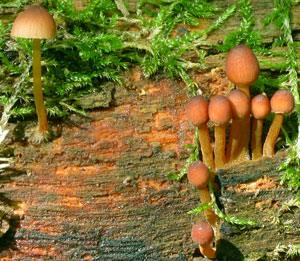In small groups or fasciculate on wood and
fallen branches of deciduous trees, e. g. Alnus, Corylus,
Fagus. Early summer to early autumn, rarely later. Reaches the northern limit of Corylus in Scandinavia; rare in western parts of the covered area (Belgium, the Netherlands, UK). In Denmark mostly recorded on Fagus with a peak in June. Widely distributed in southern Norway but not common.
Pileus 10-32
mm across, conical, parabolical, finally convex, pruinose,
glabrescent, shallowly sulcate, translucent-striate, at
first dark reddish brown, becoming paler reddish brown to
pinkish brown, darker at the centre. Lamellae
16-20 reaching the stipe, ascending, adnate, decurrent with
a short tooth, becoming dorsally intervenose with age, dingy
white; the edge concolorous or reddish brown. Stipe
15-65 x 1-2.5 mm, hollow, straight to curved, equal, terete,
pruinose, glabrescent, bright yellow, turning brown from
the base with age; the base covered with white fibrils.
Odour indistinctive to weakly
nitrous. Taste reported as slightly raphanoid.
Basidia 23-31 x
7-10 µm, clavate, 4-spored, with sterigmata
up to 8 µm long. Spores
8-10.2 x 4.9-6 µm, Q 1.4-1.8, Qav≈1.6, fairly broadly pip-shaped,
amyloid. Cheilocystidia
20-63 x 8-14 µm, forming a sterile band, fusiform,
rarely lageniform or clavate. Pleurocystidia similar,
if present. Lamellar trama dextrinoid. Hyphae
of the pileipellis 2.5-12 µm wide, smooth or covered with coarse, rounded, mostly
inflated excrescences 5-22.5 x 5-13.5 µm. Hyphae of the cortical
layer of the stipe 2.5-3.5 µm wide, smooth or covered with
scattered rounded warts or excrescences, the
terminal cells 3.5-18 µm wide, coarsely diverticulate. Clamp connections present at all tissues.
Mycena
renati is a member of sect. Rubromarginatae, although the colour of the lamellar
edge often is absent or hardly noticable, or only
visible near the margin of the pileus. It is easily
identified because of the red-brown pileus and the
bright yellow stipe. Microscopically the inflated
excrescences of the hyphae of the pileipellis should
be noticed as a reliable character.
M. bresadolana Robich &
Neville, recently described from Italy, also has a
brigth yellow stipe. It is supposed to differ from
M. renati on account of a more lilac-brown
pileus, subglobose spores, the hyphae of the pileipellis
gelatinizing, and the hyphae of the cortical layer
of the stipe smooth.
Robich (2005) described a white form of M. renati as "f. alba". |

© A. Aronsen 2004
|
Go to Sect. Rubromarginatae
|